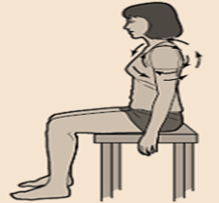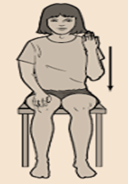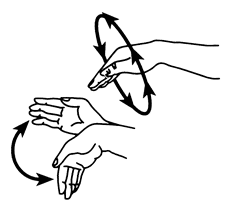Management of Lymphedema
Lymphatic massage can help the cancer patient
Our Society operates Lymphedema Clinics for cancer patients in all cities, staffed by physiotherapists trained in lymphedema management.
In the Lymphedema Clinics of the Cyprus Anti-Cancer Society, physiotherapists will evaluate each case individually, inform, give advice, suggest the most appropriate compression garment, indicate the appropriate exercises for the patients, perform manual lymphatic drainage (MLD), and/or apply a compression bandage to the swollen area. Also, patients are monitored and re-evaluated at regular intervals.
Lymphatic massage is the only type of massage that has the ability to improve health as it removes toxins from the body and eliminates swelling.
More information for lymphedema.
Lymphedema
Definition: Lymphedema is an edema (swelling), caused by the abnormal accumulation of lymphatic fluid in the body when, for some reason, the lymphatic system is underfunctioning (damage or deficiency).
It occurs more frequently on the upper and lower limbs, while it is also found on the face, trunk and genitals.
Physiology of Lymphatic System:
The lymphatic system consists of lymphatic vessels and lymph nodes that flow throughout our body.
The lymph nodes’ role is the collection of lymph fluid or else lymph (fluid composed of proteins, water, fats and body cell waste) and its transport to the lymph nodes.
The lymph nodes filter the lymph removing toxins and drain it filtered and clean back into the bloodstream.
In conclusion, lymphedema is caused by an abnormality of the normal morphology, quantity and function of lymph vessels or lymph nodes.
Within the Lymphatic System we find the following lymph node categories:
- Axillary lymph nodes (located in the armpits)
- Cervical lymph nodes (located on the neck)
- Femoral lymph nodes
- Inguinal lymph nodes (located in the groin)
- Mediastinal lymph nodes (located on the chest)
- Mesenteric lymph nodes (located in the abdomen).
- Primary lymphedema: Occurs when anatomical peculiarities in the lymphatic system are present at birth (fewer or dysfunctional lymph vessels or lymph nodes in one or more areas). In this category, lymphedema can appear before the age of 35, in which case it is called primary, or after the age of 35, in which case it is called late-onset (also known as tarda).
- Secondary lymphedema: Develops after the effect of external factors on the lymphatic system preventing its normal functioning such as:
- Surgery, especially when lymph nodes have been removed after treatment for breast, prostate, head and neck cancer, sarcoma or melanoma
- Radiation therapy, which promote the creation of fibrous tissue, resulting in the compression and block of lymphatic flow
- Accident, injury or inflammation, reasons that cause damage to the lymph vessels reducing lymph drainage
- Decrease or loss of muscle activity (paralysis). Muscle contractions (exercise, breathing) are very important and greatly assist lymph mobility
- Deep vein thrombosis (DVT)
- Cancer itself can often cause insufficient functioning of the lymphatic system
- Filariasis is the disease caused by Wuchereria parasites bancrofti, Brucia malayi or Brucia Timori. It is the most common cause of lymphedema in tropical or third world countries. Transmission occurs by an insect bite and is associated with poor hygiene conditions. As a result, rapid spread of lymphedema and its development into elephantiasis is observed.
Conservative estimates indicate that at least 20% of patients treated for breast cancer, melanoma, gynecological cancers or prostate cancer are likely to experience secondary lymphedema.
Lymphedema is classified into three stages:
- Stage I or Reversible Stage: In this stage, when pressure is applied to the edematous area, an indentation remains at the pressure point, and when the edematous limb is elevated (elevated position), the swelling temporarily subsides.
- Stage II or Spontaneously Reversible Stage: Failure to treat a Stage I lymphedema in time will lead to progressive hardening of the area, while indentation is gradually reduced until is permanently vanished, and the elevated position is no longer effective.
- Stage III or Lymphostatic Elephantiasis: It is characterized by an extreme increase in swelling in the limb, to such an extent that the limb resembles an elephant's limb, and hardening of the skin in the form of cartilage (skin thickening).
Diagnosis of Lymphedema
Many times the diagnosis of lymphedema is obvious from both the patient's history and the clinical examination.
Sometimes, however, in order to assess the lymphatic capacity and to rule out other medical problems that present similar symptoms, it is necessary to perform more specialised tests, such as:
- Lymphangiography (checks if there is any obstruction in the lymphatic system of the affected limb).
- MRI or CT scan (illustrates the problem caused by lymphedema).
- Ultrasound - Triplex (determines whether thevascular system also contributes to the symptoms and swelling of the affected limb).
There are various approaches regarding the handling and treatment of lymphedema, such as the approachof surgical treatment, conservative treatment and the approach that nothing can yield any results.
The physical therapy position - based on long-term experience with patients presenting with lymphedema - is that the outcome of the progression depends on the stage of the lymphedema and the speed of its treatment. Even in cases where it cannot be completely treated, there are ways to control and limit it, giving to patient a better functional and aesthetic result.
- Sensation of heaviness and swelling of the limb.
- Swelling of the limb or other area of the body (dents from clothing, jewelry or tight shoes may be seen).
- Pain and tension in the limb.
- Red spots that may indicate infection.
- Tingling in the fingers.
- Absence or reduction of sensation in the affected area.
- Sometimes Lymphorrhoea (discharge of lymph from the surface of the skin).
The patient, during his/her first visit, of longer duration than the subsequent visits, will get the initial evaluation and briefing. Lymphedema is treated by trained physiotherapists in one of the Cyprus Anti-Cancer Society’s Lymphedema clinics.
Appropriate measurements will be taken of the symptomatic limb, movement of the affected limb, skin appearance (wounds, injuries, dry skin, fungus), pain intensity, if any, and instructions, advice and guidance will be given.
Lymphedema is a symptom that very often affects the patient socio-emotionally (depression, shame, anger, dissatisfaction, inability to work due to reduced functionality). Thus, the physical therapist will also refer the patientto psychosocial services if he/she decided it is necessary.
After the evaluation and briefing, the treatment plan will be discussed which includes 4 stages and 2 Phases.
Stages in the treatment of Lymphedema:
- Take care of the skin
- Specialised form of massage (MLD, SLD)
MLD: This is a specialised gentle manual massage performed by people trained in lymphedema massage and its role is to guide and move the lymph from the area affected by lymphedema.
SLD: This is simple gentle manual massage, which is based on the principles of MLD. It is practiced by the patients themselves after being taught by their therapist.
- Pressure bandage, pressure clothing
- Exercise and mobilisation program: As we have mentioned above, the role of exercise in lymphedema is very important. This also applies during the period of decongestive therapyom a limb with lymphedema.
- All movements should be done rhythmically and gently, and they should not cause you pain when performing them.
- If you have an elastic sleeve, glove or both, it is recommended to wear them during exercise, thus enhancing the action of pumping lymph fluid from the lymph vessels.
- Take deep breaths, it helps the lymphatic drainage.
- Find an hour of the day on a daily basis and dedicate it to your exercises.
- If you notice any of your exercises causing pain, swelling or discomfort, stop doing them and don't hesitate to let your therapist know.
After the therapeutic period of 3-4 weeks with daily sessions is over, the patient will be taught by his/her therapist how to do self-massage (SLD) at home and will also be given an illustrated programme of exercises with all the necessary explanations about frequency and number of repetitions of the exercises.
It is very important to understand that the success and achievement of a positive result and the stabilisation of the lymphedema does not depend only on the therapist but also on the patient, observing and applying the indications suggested by his/her therapist.
The patient is re-evaluated at regular intervals so that any changes (improvement, deterioration, need to change the pressure garment, mobility of the limb) are monitored.
- Keep the swollen area clean and hydrated (use products with a low pH).
- Avoid injuries as much as possible (burns, insect bites, scratches from pets). In case of injury, clean the area with an antiseptic and apply an antibiotic ointment. If you notice that the area becomes red or painful, contact your doctor. You may need intravenous or oral antibiotics.
- It is recommended to use sunscreen and generally avoid the sun and high temperatures.
- Exercise, movement stimulates the lymphatic flow.
- Do not carry heavy objects with the affected limb (maximum acceptable weight 0.5-1 kg).
- Avoid taking blood pressure measurements or injections on the affected limb.
- Do not press or lie on the affected area.
- In the case of an air flight lasting more than 2 hours, it is advisable to wear a special compression garment.
- Elevate the affected limb on a pillow.
- Avoid moisture between the toes (hand or foot). Fungal infection is a possible reason for causing or worsening a lymphedema.
- Try once a month to always measure the same places on the affected limb to observe any increase in swelling.
- Follow a proper diet.
- Take care of your elastic garment and keep it in good condition. Wash it according to the manufacturer's instructions and when it wears out, replace it immediately.
Phase I – daily treatment for 3-4 weeks aimed at reducing swelling.
Phase II – Maintenance
Exercise, and more specifically muscle contraction, acts like a muscle pump by pushing on the lymphatic vessels resulting in the strengthening of the lymphatic pumping mechanism, which in turn helps to transport the lymphatic fluid in and along the lymphatic vessels. As a result the fluid is drained from the affected limb.
Following is a program of indicative exercises given to patients during the decongestive therapy period.
- From a sitting or supine position, first bring one knee and then the other to the chest, holding it with both hands (5 repetitions on each leg). With this exercise you achieve the decongestion of the inguinal lymph nodes.

- From a seated position with head still, turn to the right, face forward again, then turn to the left (5 reps).

- From a seated position with head straight, look up, then down and finally forward (5 reps).

- From a seated position, shrug your shoulders up and then down (5 reps).

- From a seated position, circle the shoulders, back and then forward (5 reps).

- Raise the arms to the sides up to the ears while taking a deep breath, then slowly lower them down, breathing out (5 reps).

- Massage the armpits with gentle and slow movements for 30'.

- From a supine or sitting position lift the affected limb forward, bend the elbow, touch the shoulder and bring the arm back to the starting position (5 repetitions).


- Make circles with the wrist (5 repetitions).

- Make a fist and then relax the palm (5 repetitions).

- Massage the armpits again in gentle, slow circular motions.

Eleni Christodoulou, Physiotherapist, Lymphedema therapist
Coordinator of the Physiotherapy Service of the Cyprus Anti-Cancer Society
Contact phone number: 22 446327/99807157
Email address: Eleni.christodoulou@anticancersociety.org.cy
